The closing notes of Thunder Road echoed over Slane Castle like the rumble of gathering storm clouds. As the music faded, Bruce Springsteen walked offstage for a scheduled intermission. He wasn’t sure he wanted to come back.
“I thought somebody was going to get killed, and it’d be my fault,” Springsteen recalled in Born to Run, his biography from 2016. “The crowd closest [to the front] were deeply into their Guinness and dangerously swaying from left to right. They were opening up gaping holes among themselves as audience members by the dozens fell to the muddy ground, vanishing for unbearable seconds ’til righted once again by their neighbours.”
It was June 1st, 1985, and Springsteen and the E Street Band were kicking off their largest-ever European tour in front of a crowd of more than 65,000 in Co Meath. To those who were there, the gig would be remembered as an epoch-defining rite of passage – a rare bright point amid the downpour of misery that was 1980s Ireland. Yet, for Springsteen, a break midway through the performance – between Thunder Road and Cover Me – couldn’t arrive soon enough.
He feared someone might die, if not at Slane then later, during his sell-out run of dates across Europe. He had always been a hugely driven performer since emerging from the comparative backwater of suburban New Jersey in the late 1960s. But never had it occurred to him that success could lead to this: looking out at a sea of people, wondering if someone at the front might stumble, fall and not get back up.
RM Block
“I could not face what was happening in front of the stage at Slane on a nightly basis,” he wrote. “It was irresponsible and violated the protective instinct for my audience I prided myself on.”
Backstage, he went into a huddle with his manager Jon Landau, the former Rolling Stone journalist who, in 1974, had proclaimed, “I saw rock and roll future, and its name is Bruce Springsteen.”
Springsteen wanted to pull the plug. Not just on Slane but on the entire European tour. It was, of course, unthinkable that he could quit in such a fashion halfway through a concert. Who knew what might happen? Springsteen ultimately emerged for the second portion of the set. He relaxed as the sun went down, watched by an attendance that included Eric Clapton, Pete Townshend and Elvis Costello.

“The crowd settled during the second half of the Slane show and I observed there was a sketchy but ritual orderliness to what appeared from the stage to be pure chaos. The crowd protected one another,” he recalled. “If you fell, the nearest person to your left or right reached down, grabbed an arm and pulled you upright.”
Passion, booze, madness and comradeship: so began Springsteen’s special relationship with Ireland. A new chapter in that friendship opens this month as he returns for an all-Ireland tour that will feature dates in Kilkenny, Cork and Dublin after starting in Belfast on Thursday. Springsteen, who is 74, won’t be on the road forever, and this latest Irish run might be among the few remaining chances to see a rock icon in the flesh.
“Slane was my Bruce awakening,” says Jon Jones, bassist with the Springsteen tribute band The Human Touch, who play the Springnuts Bruce Springsteen festival on Tory Island, in Co Donegal, this weekend.
His memories of Slane are less dramatic than the recollections of the singer himself. “Standing in an open field with 100,000 people” – estimates of the attendance vary wildly – “is not something your brain can comprehend. People forget how big he was for those few years in the 1980s. Bruce Springsteen was a household name. It was Bruce, Madonna, Michael Jackson and Queen.”
Jones isn’t the only one for whom Slane burns brightly – not as a fond musical memory but as a life milestone. “My boyfriend – five years older – had tickets. I was definitely not allowed to go. At school, none of my friends were allowed to go,” recalls Sheila Burton, an artist based in Wexford, who was 17 at the time. She is a lifelong Springsteen devotee who will be up front in Belfast when Springsteen takes to the stage at Boucher Road.
“Did that stop me? Of course not. He was my hero; he understood me, his songs were about my life, and he was completely gorgeous. Threatening to leave home if my parents didn’t change their minds, I boarded a bus bound for Slane on a sunny Saturday in June with my hopes and dreams and my 22-year-old boyfriend.”
Her memories have faded slightly with time, but the emotions “remain vivid, as if the experience happened just yesterday”. She talks about the sun blazing down and the huge crowd surging forward. “I stood near the stage, the firemen spraying us with water, and then he appeared, Born in the USA blasting.”

Four decades later Springsteen is still one of rock’s most potent forces. He played to a combined European audience of more than 1.6 million last year, while his latest tour has grossed $379 million so far, behind only Taylor Swift and Beyoncé (and ahead of Coldplay) in the past 12 months.
“The reason that his music has such an emotional impact on his fans is that they see themselves in him. His persona has always been that of the regular guy. You always get the feeling that he is enjoying the performance as much as the fans are. He is, himself, first and foremost a fan,” says Nigel Brothers, The Human Touch’s singer. “His music is a combination of everything that went before him, from Elvis Presley to Bob Dylan, from Chuck Berry to James Brown, from Buddy Holly to The Beatles, and from Roy Orbison to the Stones and The Animals. It’s music for the heart, the soul, the mind and the feet.”
Springsteen has a rich legacy of recorded work: the blood and thunder of Born to Run, the big-sky melancholy of Nebraska and the blue-jean pop-rock of Born in the USA, the LP that finally brought him to Ireland. But the singer’s music takes on a new dimension under the spotlight, as anyone who witnessed his extraordinary shows at the RDS in Dublin in May 2023 will testify.
“I’m really lucky to have seen Bruce up to 50 times in various countries across the world, and it never, ever gets boring,” says Hannah Summers of Hungry Heart, the Springsteen club night that is holding an after-party following the singer’s gig at Croke Park. “That’s partly from his performance style but also the changing set lists. There’s a sort of safe unpredictability from being at his concerts – the thrill of not knowing what you’re going to get next, but that guarantee that you’ll be happy with it.”
His upbringing in New Jersey perhaps makes his music especially resonant with Irish audiences: Springsteen, who during his time here last year visited Rathangan, in Co Kildare, where his great-great-great-grandfather grew up before emigrating to New Jersey, in 1853, sings about wanting to escape the stifling boredom of small-town life and head off into the great unknown.
“If you think back to Ireland in the late 1970s and early 1980s, there was very little hope of a future for the youth at that time. Between the Troubles and high unemployment, emigration was the order of the day,” says Brothers. “So you could see how relatable songs like … Born to Run and Thunder Road” – his two great anthems of escape – “could be. Bruce was from an Irish-Italian background [though his father was of Dutch heritage] and he was raised a Catholic, and that played a big part in his writing through his career. The religious imagery, morality and struggle were ever present in his work. There is no doubt in my mind that this subconsciously resonated with his Irish fans.”
[ Where’s Bruce? Springsteen born to run all over townOpens in new window ]
Springsteen approaches touring with near-spiritual fervour, though he has also been upfront about the challenges of putting on a knockout show every night.
“Performing is like sprinting while screaming for three, four minutes,” he told the New Yorker in 2012. “And then you do it again. And then you do it again. And then you walk a little, shouting the whole time. And so on. Your adrenaline quickly overwhelms your conditioning.”
He had perfect clarity, however, about why he continues to give everything to his audience. Rock’n’roll for Springsteen is a kind of freedom.
“For an adult, the world is constantly trying to clamp down on itself,” he said. “Routine, responsibility, decay of institutions, corruption: this is all the world closing in. Music, when it’s really great, pries that shit back open and lets people back in, it lets light in, and air in, and energy in, and sends people home with that and sends me back to the hotel with it. People carry that with them sometimes for a very long period of time.”
The objective has always been the same: to play until everyone was ready to drop – not the musicians but the audience.

“We had a saying,” Springsteen’s saxophone player Clarence Clemons told Rolling Stone in 1986 as the E Street Band looked back on Slane. (Clemons died in 2011, his place in the E Street Band taken by his nephew Jake.) “Are they still on their feet? Yeah, let’s go back and get ’em. Can they still raise their hands? If they can, we haven’t done our job.’ When we finally saw the guys in the front row falling, lying over each other, then we said, ‘Okay, they’ve had enough. Let’s go home.’”
Springsteen was full of life at the RDS last year. Yet the shadow of mortality hung over the evening, too. In one moving anecdote he talked about the band he had formed as a teenager in New Jersey and noted that he was the only member still alive. The performance finished with I’ll See You in My Dreams, a meditation on growing older and what comes next. “Death is not the end,” Springsteen sang with gut-punching poignancy. Then the lights went out.
“He’s had close friends pass away much younger than they should have, but ... perhaps he’s at the point where he’s considering how long he may have left,” says Hannah Summers. “I think becoming a grandparent, which he was fairly recently, must put that into sharp focus too.”
“The shows have been extremely emotional,” agrees Brothers, who says this latest Irish tour is sure to become a cherished memory for Springsteen fans – much like Slane in 1985. “Every time I get to see him – 28 times and counting – I always fear that it might be the last. Someday I will be right. So let’s enjoy it while we still can.”
Bruce Springsteen and the E Street band play Boucher Road, Belfast, on Thursday, May 9th; Nowlan Park, Kilkenny, on Sunday, May 12th; Páirc Uí Chaoimh, Cork, on Thursday, May 16th; and Croke Park, Dublin, on Sunday, May 19th





















